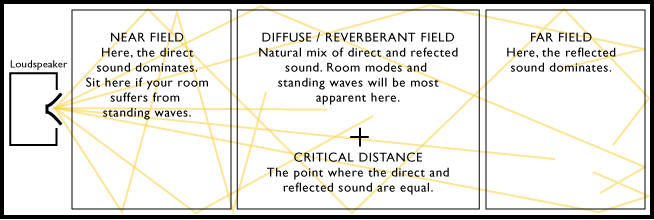1. How sound behaves and reflects in different environments.
2. The theories of reverberation.
You may wish to read our article on room acoustics to find out how sound behaves in a room.
What is reverberation?
In a room a pattern of echoes will build up shortly after a source has begun to generate sound. Echoes are discrete (individually distinct) sound reflections. Reverberation then, is the combined effect of many discrete echoes. It is the most complex time-domain effect and places a sound within the context of its space.
Direct sound
Direct sound is that which arrives at the listeners ear direct from the source .
Reflected sound (echoes)
Reflected sound is that which arrives at the listeners ear after bouncing off a surface or object. Read more about acoustics here.
Ambient sound
In all acoustical spaces (rooms) there will be a mixture of direct sound and reflected sound (also called the diffuse or reverberant sound). This mixture is called the Ambient sound.
Near field
Close to the source the direct sound will dominate. This area is called the Near field.
Far field
As the listener moves away from the source the ratio of direct sound to reflected sound changes. At a certain distance the amplitude of the reflected sound may become equal, or greater than the amplitude of the source. This area is called the Far field.
Critical distance
At a certain distance away from the source the direct and reflected sound are equal in amplitude. This point is called the critical distance.

You may wish to read our article on room acoustics to find out how sound behaves in a room.
